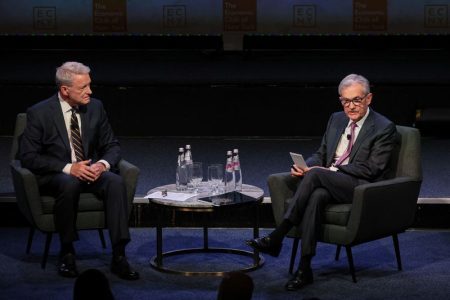By Howard Schneider
WASHINGTON (Reuters) – With asset values from stocks to crypto to homes piling higher, inflation still considered too high, and worries of “exuberance” creeping into the conversation, Federal Reserve Chair Jerome Powell on Wednesday will update U.S. lawmakers on the economy and prospects for interest rate cuts in a politically charged election year.
The landscape he’ll lay out is in many ways encouraging, with the unemployment rate a low 3.7%, inflation by some measures within striking distance of the Fed’s 2% target, and the economy still growing despite the tight credit conditions imposed by the central bank.
But the next steps remain uncertain, with recent inflation readings stickier than expected in key ways, and some Fed officials and outside analysts concerned the U.S. economy remains too strong for price pressures to fully recede – an argument for rate cuts to be delayed further than anticipated.
Powell kicks off two days of testimony with a 10 a.m. ET (1500 GMT) hearing before the House Financial Services Committee, explaining to lawmakers who face inflation-weary voters this November why he is confident price pressures will keep easing without upending the job market or conversely why the window for a “soft landing” may be narrowing.
The best-case outcome “is hardly assured,” Atlanta Fed President Raphael Bostic said on Monday in the last policymaker comments before Powell’s House testimony. Bostic fretted “pent-up exuberance” among businesses could lead to a spending surge and renewed inflation if the Fed cuts rates too soon.
The comment somewhat echoed Alan Greenspan, the former Fed chair who three decades ago called out the “irrational exuberance” driving a developing bubble in technology stocks.
Now the Fed’s quandary is that, even as it has held its policy rate steady since July at 5.25%-5.5%, the highest in more than 20 years, overall financial conditions have been easing and asset prices rising on expectations of Fed rate cuts, a dynamic that could make inflation harder to tame.
In his House appearance and a follow-on hearing on Thursday before the Senate Banking Committee, investors will be listening closely for any effort by Powell to shift rate-cut expectations currently pointing to a June start and reemphasize the fight against inflation is incomplete.
APPROACHING CUTS ‘CAREFULLY’
Since the Fed’s Jan. 30-31 meeting, data has accumulated in a tit-for-tat fashion: Reports bolstering the soft-landing narrative, such as encouraging figures on services prices on Tuesday or signs of slowing consumer spending, have been counterbalanced by others showing inflation stuck in significant ways, such as from still-rising shelter costs, or evidence of unexpected economic strength, such as January’s outsized gain of more than 350,000 jobs.
Many economists feel any shift in the Fed’s outlook is likely to be towards fewer and later rate cuts. Citi analysts on Tuesday noted “a much less benign environment where high inflation is increasingly likely to keep policy rates elevated until activity slows more sharply.”
Still, this week’s hearings will contrast with Powell’s previous congressional appearance last June when inflation was still double the Fed’s 2% target and policymakers anticipated more rate hikes. What was likely the final rate hike was approved the following month.
With the Fed’s next move now seen as a rate cut, the change in tenor of the hearing will be notable.
Powell has made a point as chair to cultivate ties with Democratic and Republican lawmakers alike. That has been aided by his reputation as a centrist with Republican roots who was named a Fed governor by former President Barack Obama, a Democrat, elevated to chair by former President Donald Trump, a Republican, and given a second four-year term as chair by President Joe Biden, another Democrat.
While the deep U.S. cultural divide over issues like abortion and immigration may dominate the campaign, the Fed’s decisions could determine whether the likely rematch between Biden and Trump occurs in an environment of low inflation, low unemployment and falling interest rates that typically favors an incumbent or in more challenging conditions.
Members of a closely divided but Republican-controlled House all face voters in November. While only some members of the Democratic-led Senate panel are up for reelection, those include Chair Sherrod Brown of Ohio, who has already urged Powell to get rate cuts underway given the decline in inflation.
Since late last year Powell has been laying the groundwork for rate cuts to begin, but also has been careful not to commit.
“We have a strong economy. Growth is going on at a solid pace. The labor market is strong: 3.7% unemployment,” Powell said in an interview with the CBS news show 60 Minutes in early February, his most recent public comments on monetary policy. “The prudent thing to do is…to just give it some time and see that the data confirm that inflation is moving down to 2% in a sustainable way…We want to approach that question carefully.”
(Reporting by Howard Schneider; Editing by Dan Burns and Andrea Ricci)

